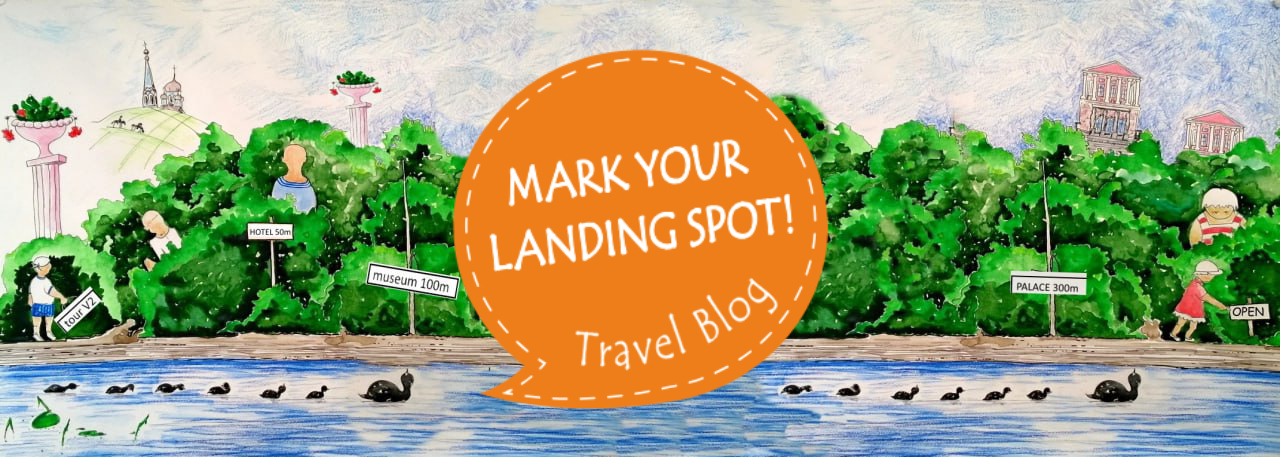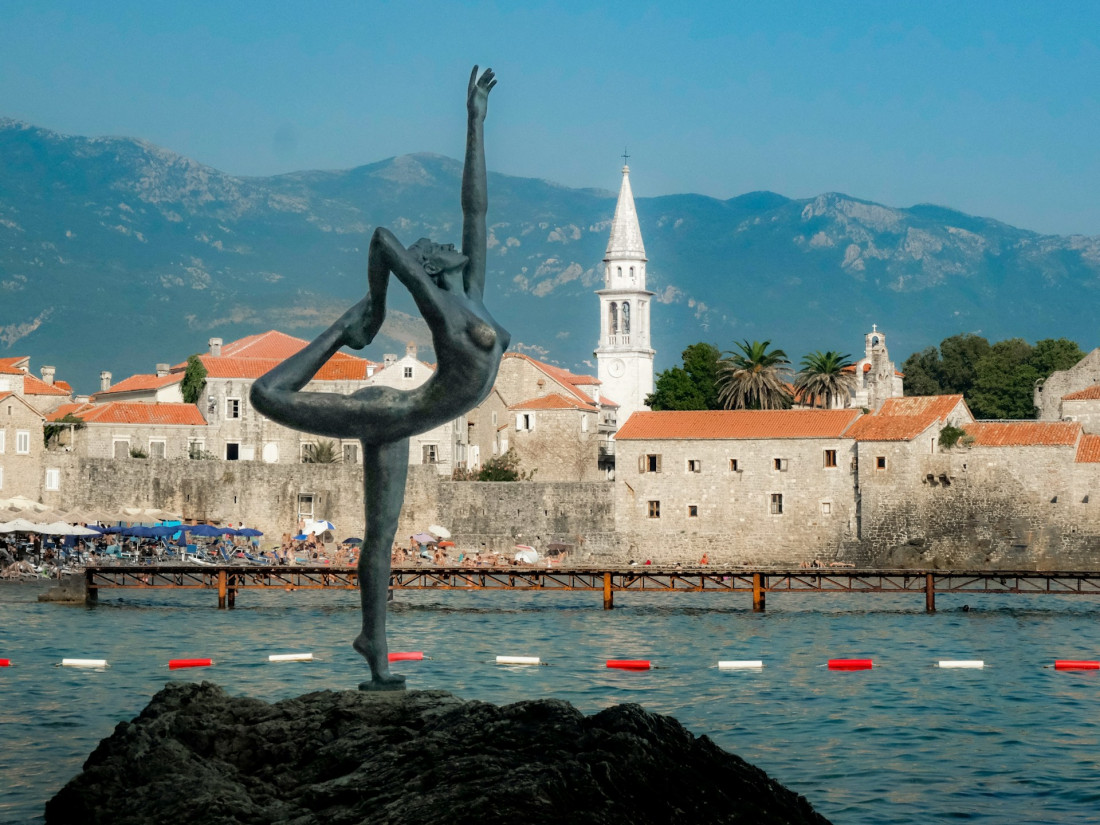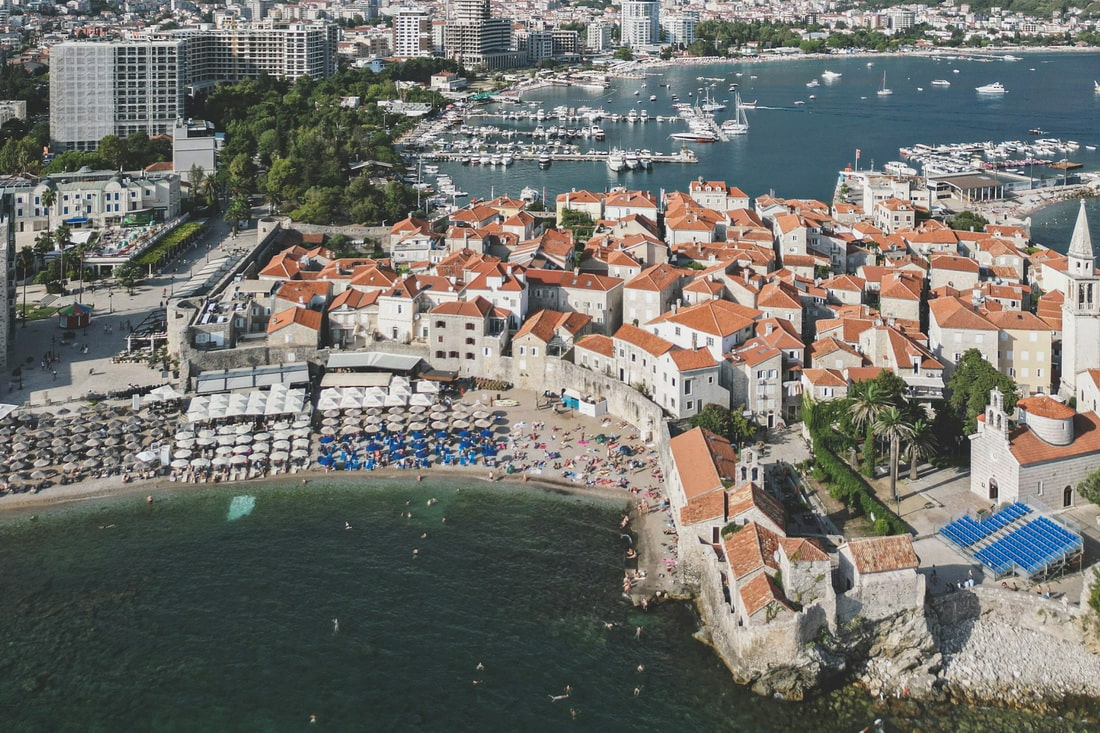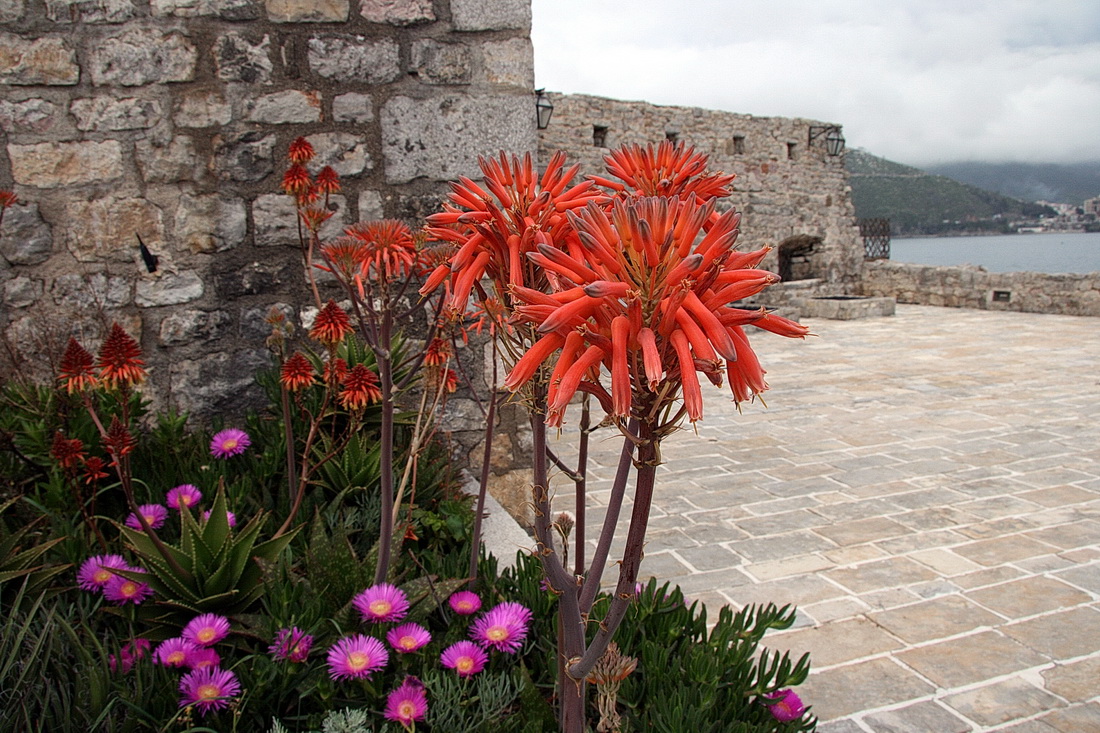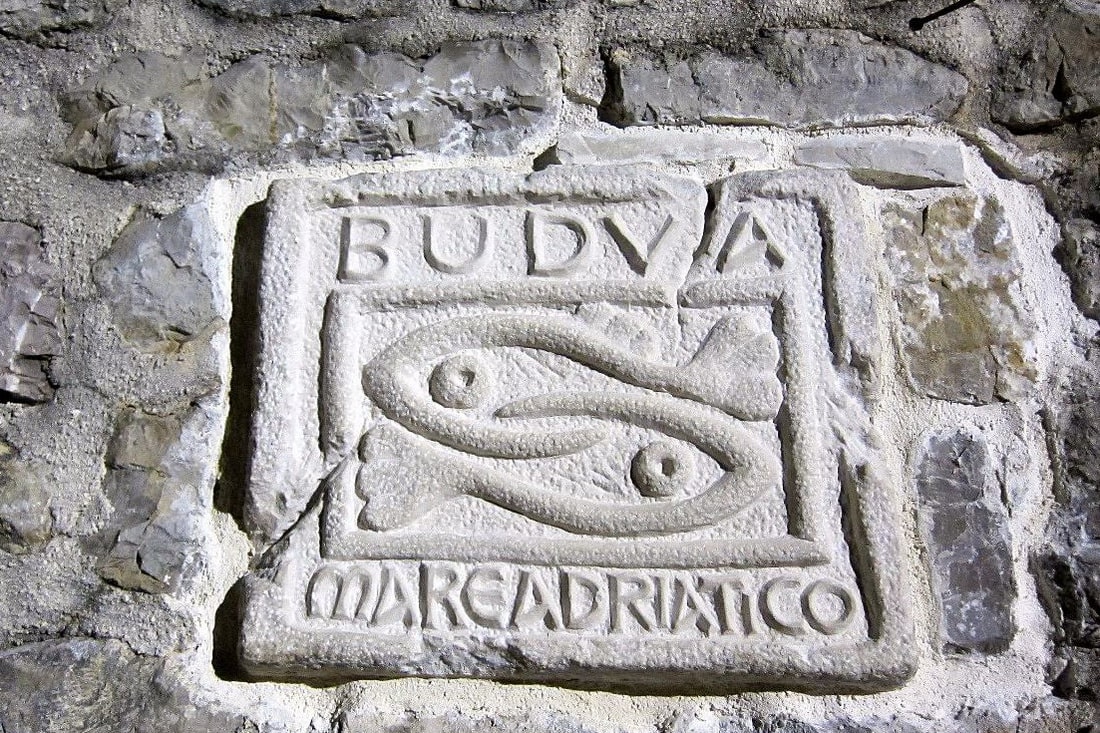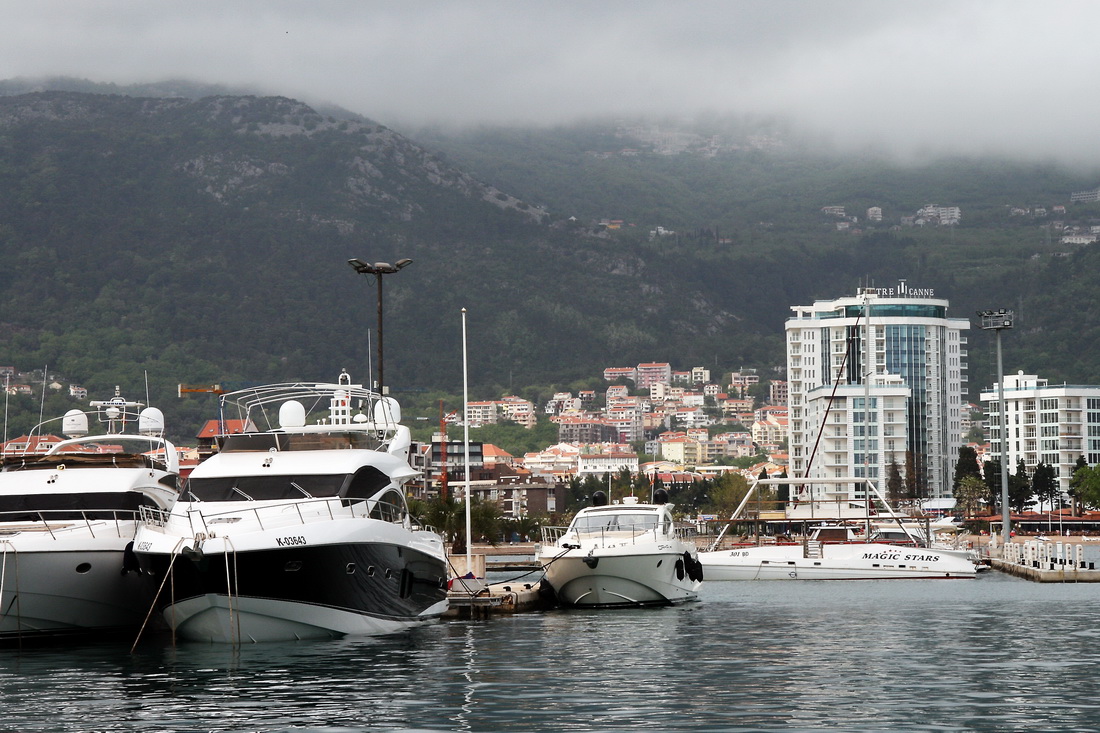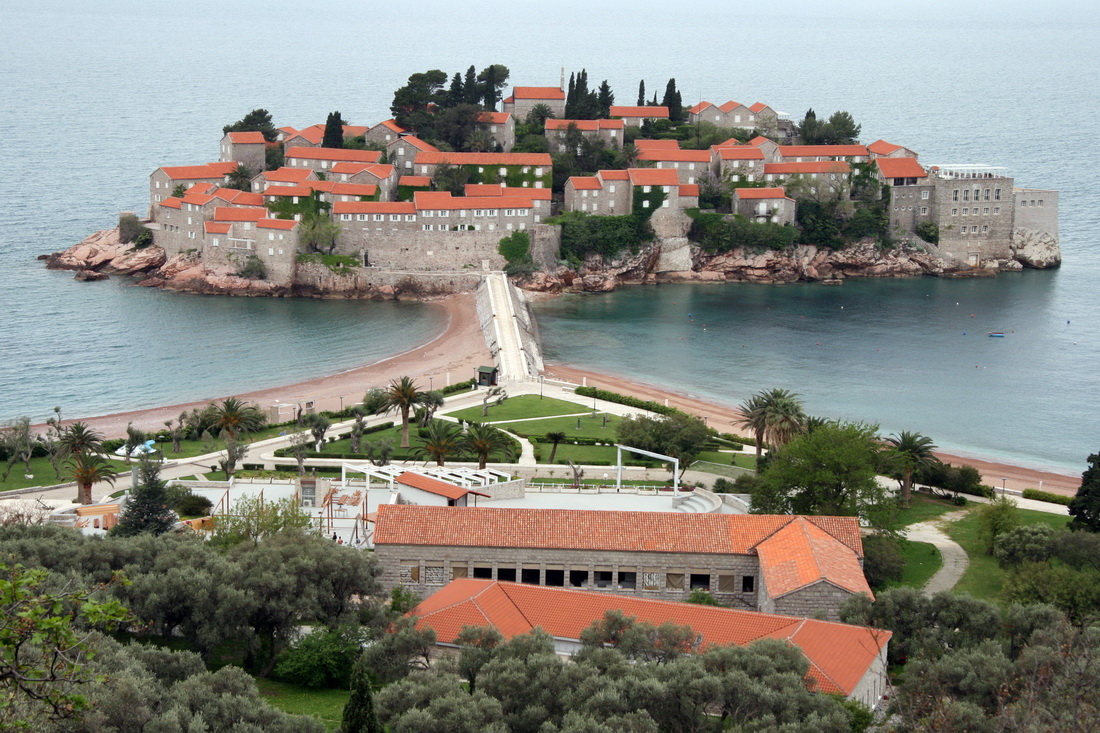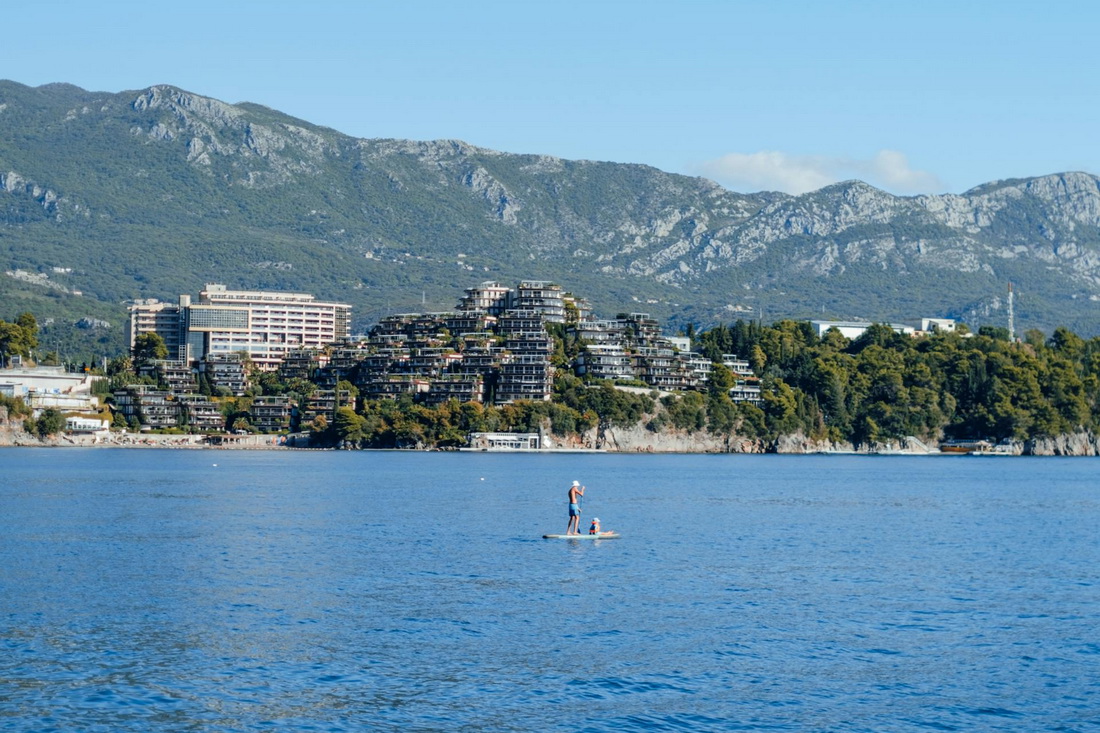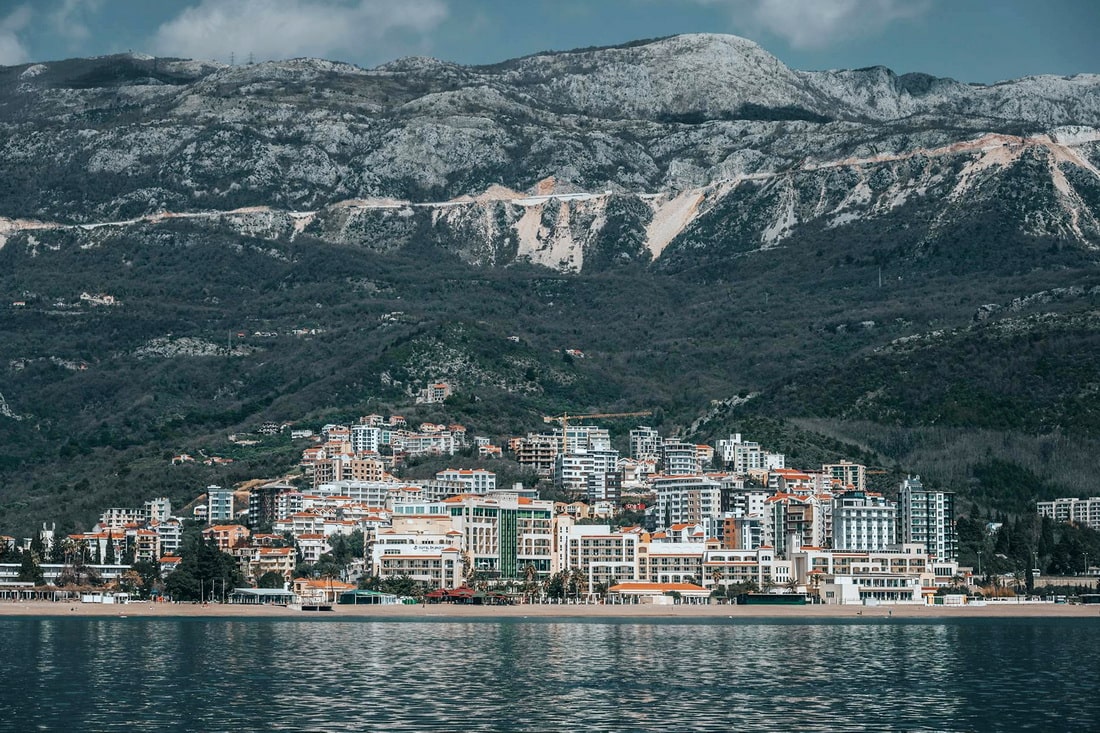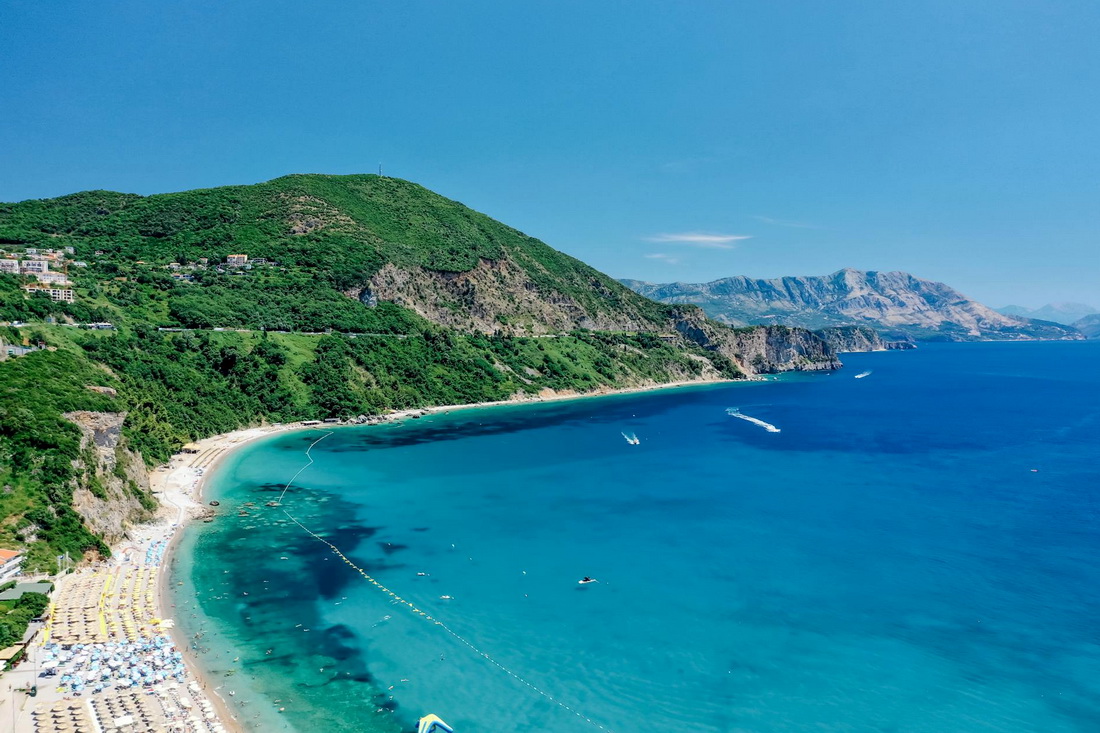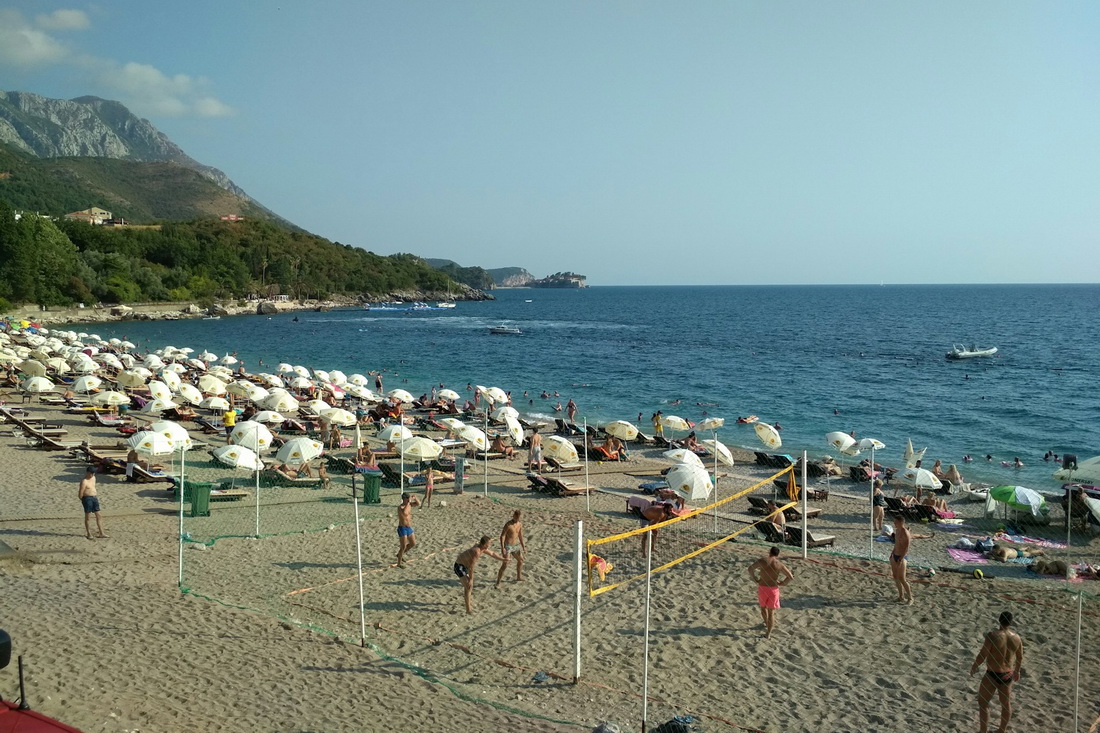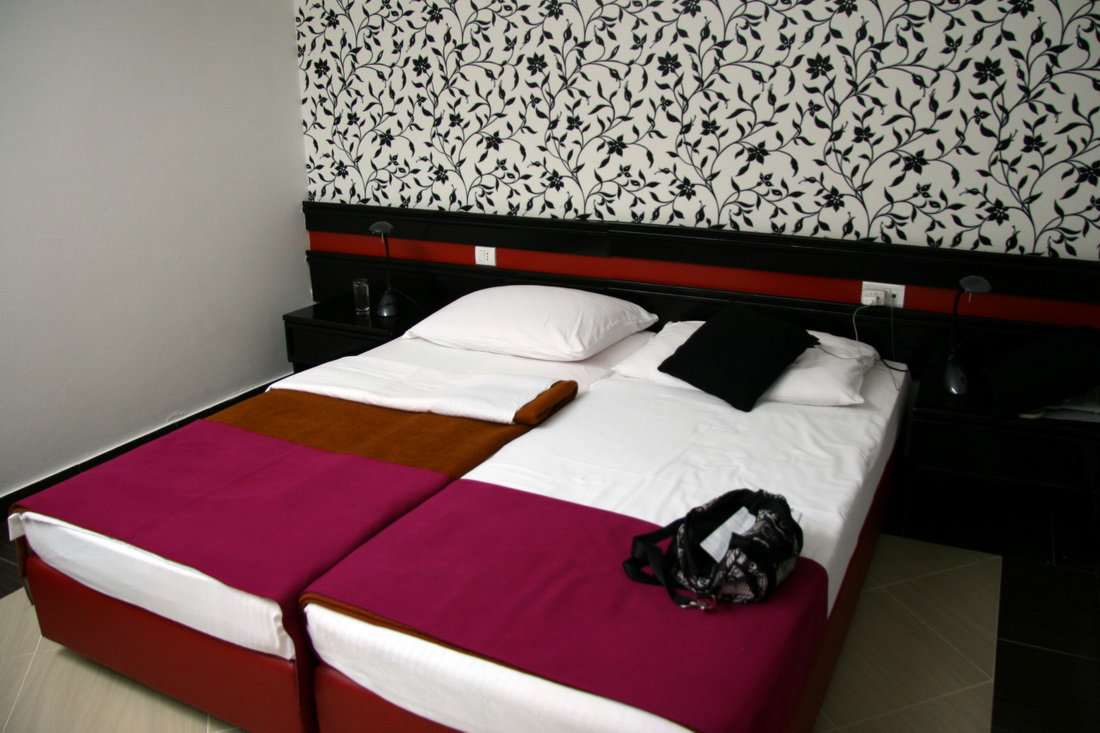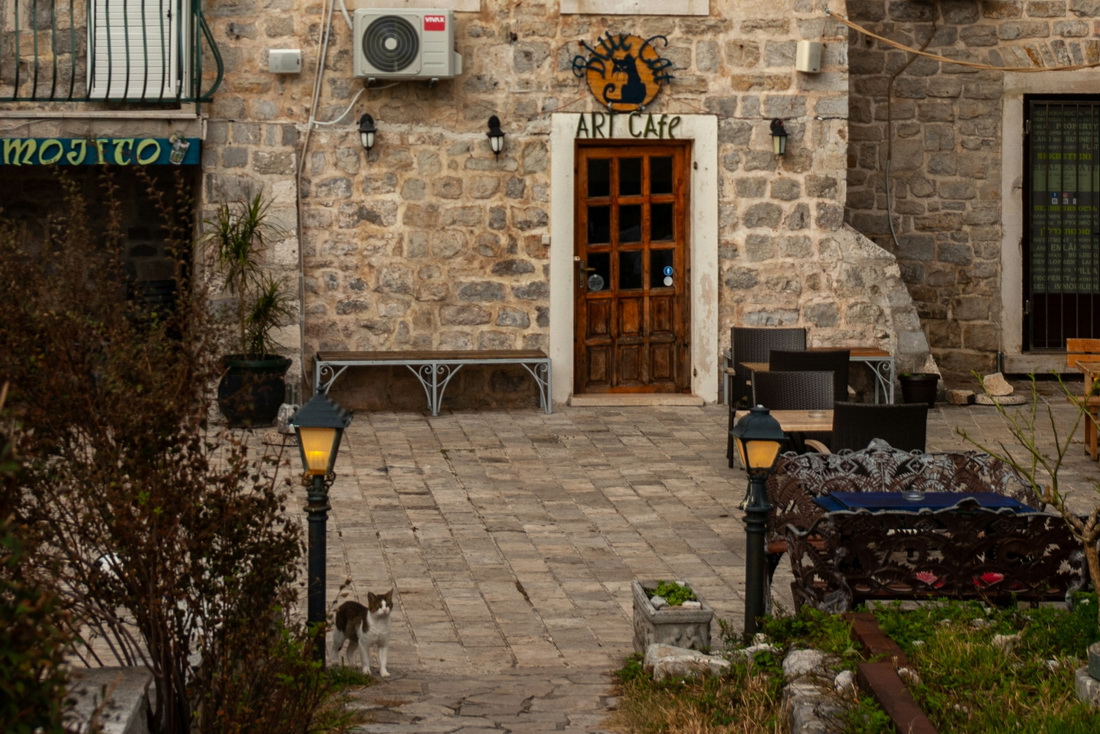Budva is a charming town with a population of around 17,500 locals, but it becomes lively and bustling with tourists during the peak season. Many visitors stay for a week or two, or even longer, to soak up the sun and enjoy the sea.
Why Budva?
The town is compact, vibrant, and green, divided into two main areas: the quaint old town and the newer section. The old town, though sparsely populated, is packed with cafes, restaurants, and souvenir shops. You can explore it in about half an hour, making it a perfect spot for an evening stroll after a day at the beach or hiking.
The newer part of Budva features residential buildings, hotels, guesthouses, restaurants, and shopping centres. Unlike Kotor, Budva boasts large beaches right in the city, although it’s worth walking a bit further to find less crowded spots.
One of the things I love about Budva is the abundance of walking opportunities. You can stroll along the coast, hike up into the mountains, or take a boat trip to explore the area.
Like other Balkan countries, Montenegro has its challenges—poor transport connections, uneven service quality, and traffic jams. However, these are balanced by the friendliness of the people, the warm sea, and the stunning natural scenery.
Now, let’s dive into the details.
What to see in Budva
Budva, with a history spanning around 2,500 years, has been shaped by the Greeks, Romans, Byzantines, and Venetians. For tourists, it’s an excellent base for exploring nearby destinations like Sveti Stefan, Tivat, and Kotor. However, there’s plenty to keep you entertained right in Budva, with numerous events and attractions to enjoy.
Although many of my photos show cloudy and overcast weather, that’s actually more the exception than the norm. Coming from a northern country, I usually avoid walking in bright sunlight.
1. Old town
The Old Town is compact and tiny, but you’ll never tire of wandering its streets, even daily. The sunsets from the fortress walls alone make it worth the visit.
Behind these walls, you’ll find four historic churches and charming houses lining narrow pedestrian streets. This picturesque area was destroyed in the 1979 earthquake but has since been rebuilt.
Today, these houses are home to a variety of restaurants, cafes, souvenir shops, and hotels. Street musicians add to the lively atmosphere, and during the summer, festivals are held almost every week.
Here are the highlights of the Old Town:
♦ Sveti Ivan

Sveti Ivan is one of the few churches in Montenegro that you can actually enter, it is quite simple and has just a set of icons to see.
The Church of Sveti Ivan (St. John) is a charming old church originally built in the 7th century and rebuilt several times.
Its 36-meter bell tower, erected in 1867, is the most recognizable building in Budva. Inside the Catholic church, the mosaic style of the altar wall is unique. Entry is free.
♦ Citadel
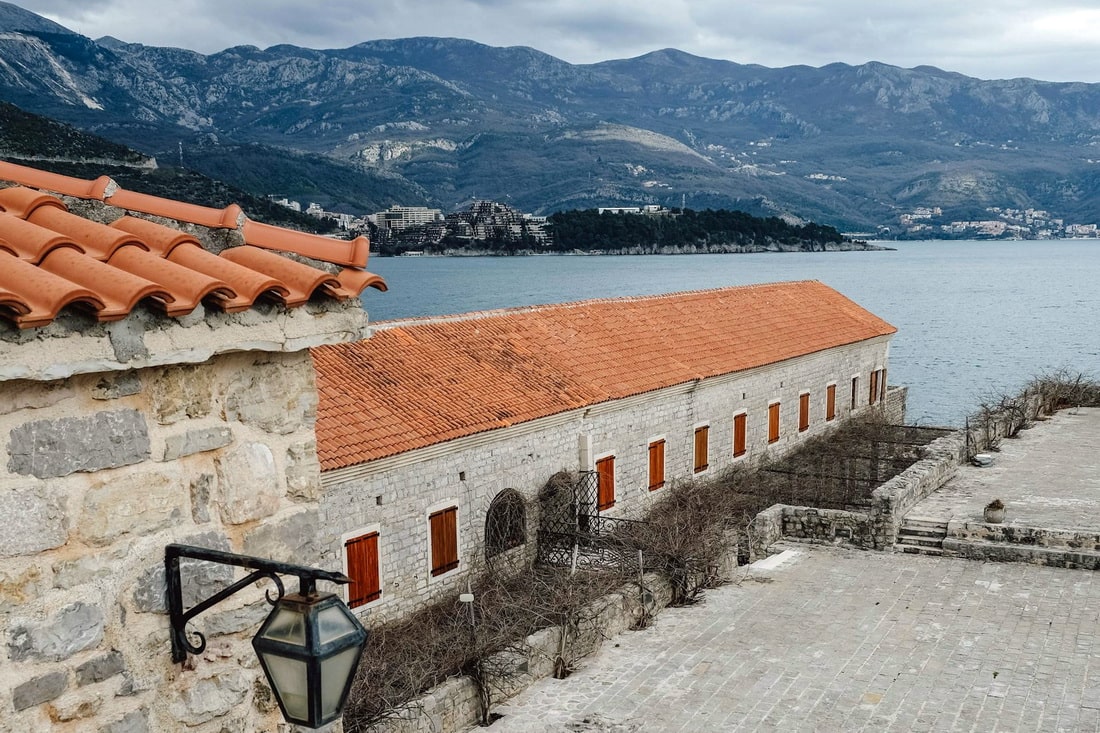
Visit the Citadel for beautiful sea views and a glimpse of one of the Adriatic’s most impregnable fortresses.
The Citadel, or Fortress of Saint Mary, was built by the Venetians in the 15th century and was once the largest and most impregnable fortress on the Adriatic coast.
Inside, you’ll find a small museum, a tiny library with books in glass cases, and an observation deck offering stunning views of the city and Sveti Nikola Island opposite Budva. It’s especially beautiful at sunset.
An entrance ticket costs €4.5, but it’s free for restaurant guests.
♦ Budva city wall
The city walls, constructed in the 9th century, offer similar views to those from the Citadel but at a lower cost: entrance is €2.
Unlike in Dubrovnik, where the walk is circular, here you reach a dead end and have to return the way you came. One entrance is near the gates opposite the Avala Hotel. To get there, walk through the summer terrace of the Mozart restaurant. The other entrance is by the Citadel.
♦ Fish relief
Another symbol of Budva is the relief of two intertwined fish. This relief decorates the wall of the Citadel and symbolizes the tragic love of Budva’s own Romeo and Juliet — Elena, a beautiful girl from a wealthy family, and Marko, a stonemason.
According to legend, when the girl’s parents wouldn’t let them marry, the lovers threw themselves into the sea, turned into fish, and were never separated again. A voice from the sea was heard saying, ‘Let two be as one’ (Ko jedno nek budu dva), which is where Budva’s name comes from.
There’s a belief that anyone who touches the relief will make their love strong and eternal like the stone.
2. Promenade
Right next to the Old Town walls begins the promenade and port. Unlike nearby Tivat, the marina here is small. You might see a few yachts, but mostly fishing and tourist boats.
These boats offer trips to the island of Sveti Stefan (you’ll have to view it from the boat as landing isn’t allowed) or Sveti Nikola.
Private trips with a self-chosen route start at about €60. Alternatively, you can reach popular places with shuttle boats, costing €8-10 for a round trip. Check the schedule with the captain and choose a convenient return time. There are also 1-1.5 hour group boat tours.
The promenade is lined with cafes, restaurants, and ice cream stands. There are benches in several spots. The promenade is narrow, and in the summer, it gets very crowded.
3. Dancing girl
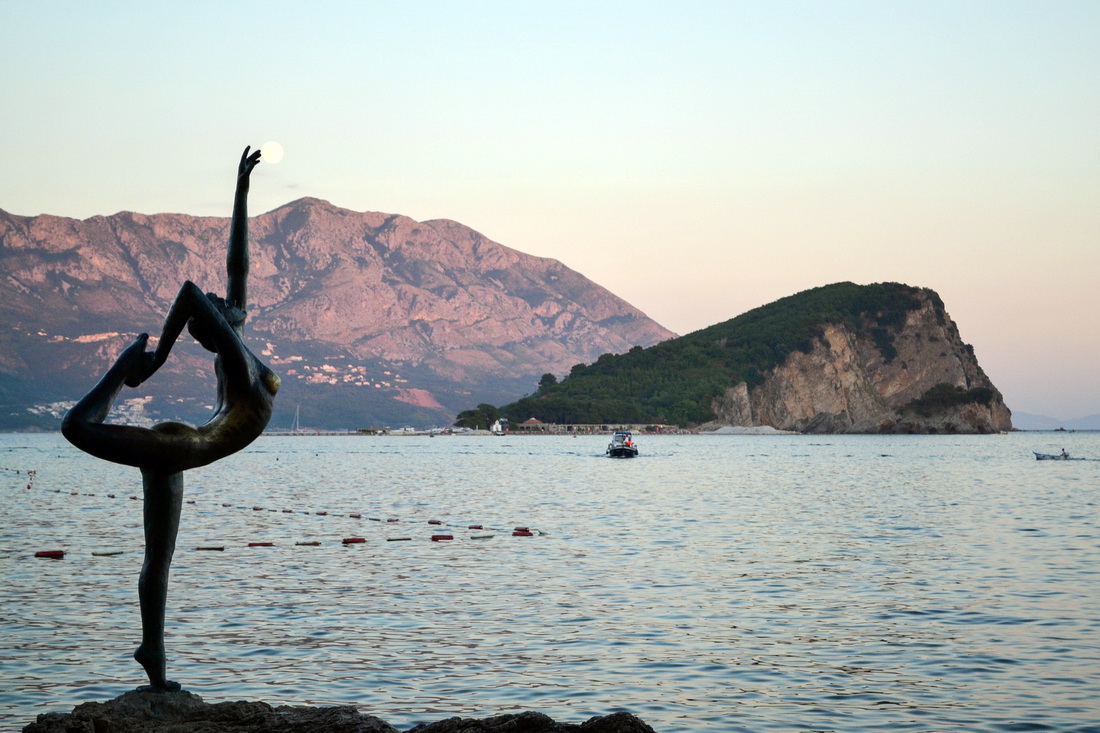
The statue is located outside the old town, and you have to take a short walk to see it, but it’s not far.
Copenhagen has the Little Mermaid, and Budva has the Dancing Girl — perhaps a ballerina or gymnast.
According to popular legend, sculptor Gradimir Aleksić created her, inspired by the beautiful and sad love story of a dancing girl and a sailor.
The sailor went on a long voyage, and the girl, waiting for him, danced on the shore every day. The sailor never returned, but the girl remained faithful to him, continuing to wait by the sea until her death.
You can find her along the seaside path, 200 meters from the Old Town towards Mogren Beach.
4. Podmaine Monastery (Podostrog)
The monastery is located on a hill above the city, next to the Maine nightclub. It’s a fairly easy 2 km walk from the Old Town through a quiet residential area.
This active Orthodox monastery was founded in the 15th century and was once the residence of Montenegrin kings. There are two churches, built in the 12th and 18th centuries.
The garden makes for a great photo opportunity. The view of the bay is fantastic.
Since the monastery is active, dress appropriately — no shorts or low-cut tops. The monks are friendly and happy to show you around and tell you about the monastery’s history.
5. Sveti Nikola Island
Sveti Nikola Island is an uninhabited piece of land just 1 km from Budva. The island is also called Hawaii because of the restaurant on the beach with the same name.
It’s worth visiting for its clean sea and cosy little coves. Until recently, the island was a nature reserve with 50 deer, as well as pheasants, mouflons, and hares. Unfortunately, the deer are no longer there.
Sveti Nikola Island is 2 km long. You can relax only on the ‘spit’ of the island, where Hawaii Beach is located. Entrance is free.
Renting two sunbeds and an umbrella for the day costs €10-15, depending on which cove you choose. You can also sunbathe on your towel. In July and August, the island can be crowded. The water has large rocks, so be careful.
The island has one restaurant and two bars. Prices in the restaurant are twice as high as in Budva. If you plan to stay on the island all day and want to save money, bring food and water from Budva.
You can’t walk around the entire island; most of it is private property and fenced off. Boats head to the island every 20-30 minutes from several piers in Budva. From 7:00 to 19:00, you can explore the island. The round trip costs €3-5.
6. Zelena Pijaca
Zelena Pijaca is the main market and a colourful spot to visit. Dozens of vendors sell vegetables, fruits, meat, cheese, olive oil, and honey. It’s worth a visit if you love markets and want to find something new to try, like blackberry wine or pršut.
While vendors often share stories about how they grew their produce and how good the season has been, most of the fruits are not local and are brought in from other countries.
Best hiking spots around Budva?
Budva is a small town, and it’s convenient to go hiking no matter where you stay. Here are some popular and easy trails.
1. Budva – Mogren Fortress, 3 km
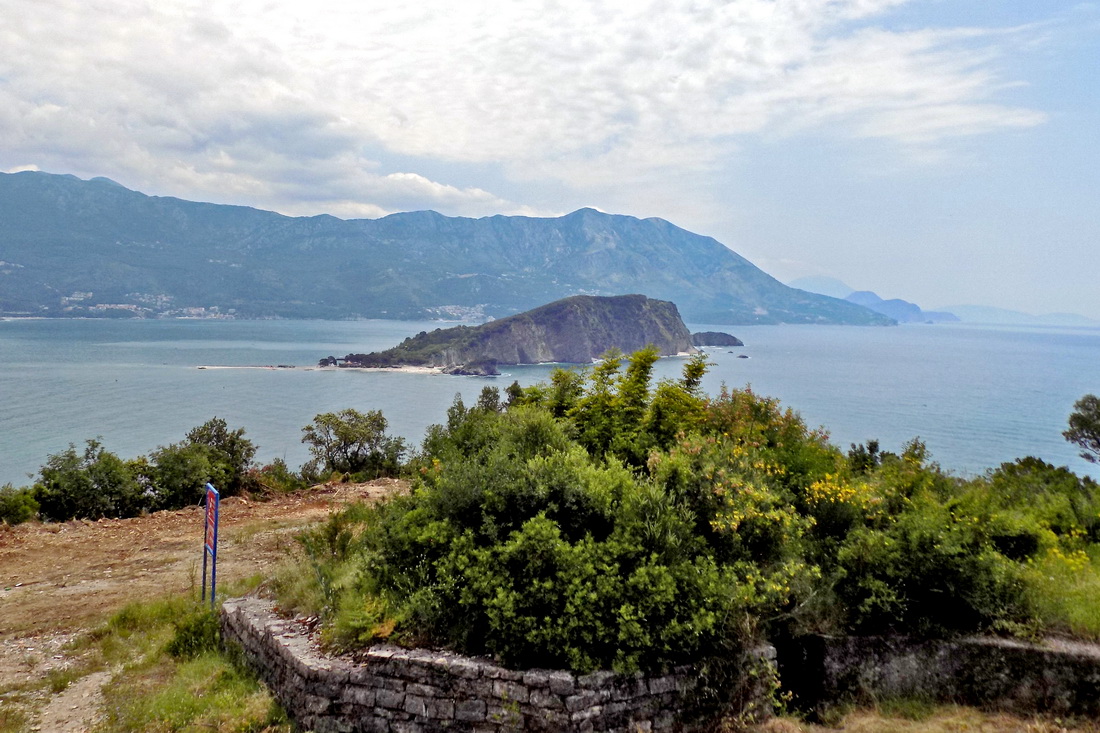
The shortest hiking trail leads to the Mogren Fortress. You can hike up here as an alternative to your morning exercise.
Mogren Fortress is located above Mogren-2 Beach. Built by the Austro-Hungarians in 1869, it stands as a historical monument.
Unfortunately, the fortress is in poor condition due to a strong earthquake. Overgrown with grass, it is not guarded. Entry is free, and there are no guided tours, so you won’t find many people there.
From the fortress, you get a great view of old Budva and Sveti Nikola Island.
A steep path leads vertically up from Mogren Beach, or you can walk 3 km along the road from Budva — it goes uphill all the way.
2. Budva – Bečići – Rafailovići – Kamenovo – Sveti Stefan, 9 km
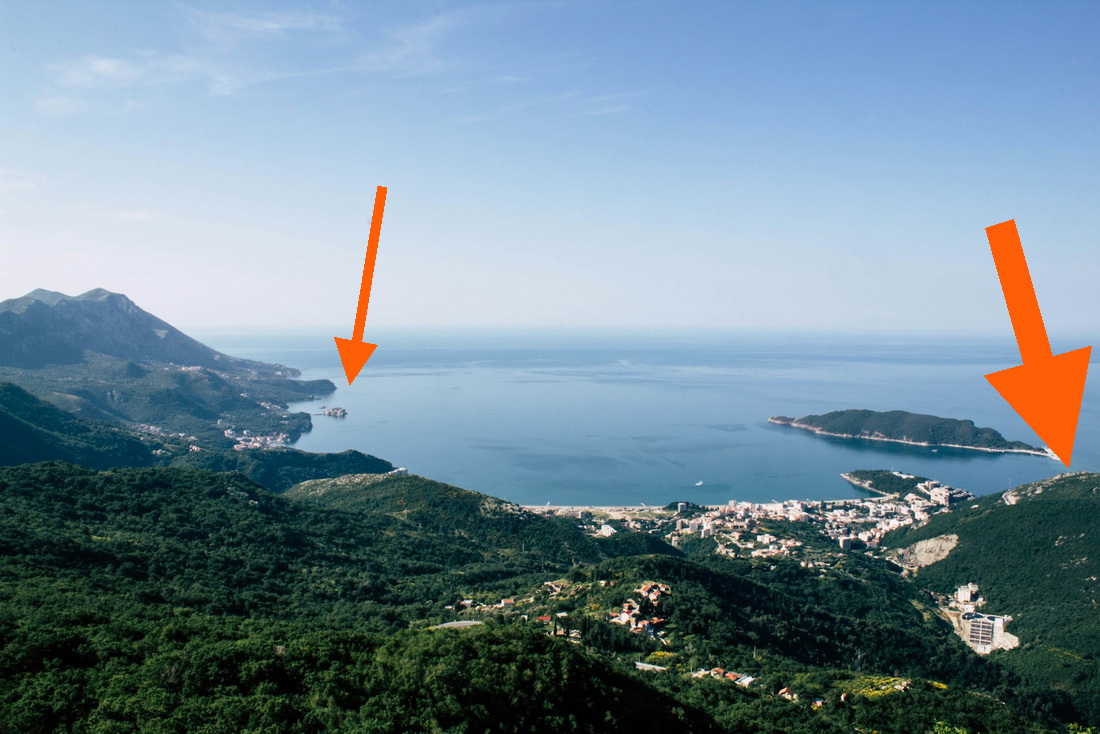
The thick arrow shows where Budva is, and the small arrow points to the final destination of the hike, Sveti Stefan.
This scenic and relatively easy route starts with connected promenades: Budva, Bečići, and Rafailovići. The Rafailovići promenade is lined with restaurants, perfect for a break and a meal.
After Kamenovo Beach, the path becomes a narrow trail through a small forest, then climbs stairs to the main road. This part, though less pleasant due to passing cars, is only 750 meters long. After the Pržno sign, descend a path back to the sea.
Pržno is a charming village with two small beaches and several restaurants. While the restaurants are expensive, the beaches are worth a stop.
The route then passes through the Royal Park Miločer, a former royal residence and favourite of Yugoslav leader Josip Broz Tito. The park features the Queen’s Beach, a botanical garden, and great views of Sveti Stefan.
Sveti Stefan is one of Montenegro’s most iconic sites. Access to the island is restricted as it houses the luxury Aman Hotel, currently closed. You can also hike to the viewpoint above Miločer for a stunning view of Sveti Stefan.
A round-trip walk along the coast takes about six hours. But you can return to Budva by bus, which runs every half hour from the stop above the Sveti Stefan parking lot. The fare is €2.
Beaches in and around Budva
Many people flock to Budva for its beautiful beaches and clear sea. The Budva Riviera stretches over 35 kilometres, offering several key spots to relax and enjoy.
Richardova Glava
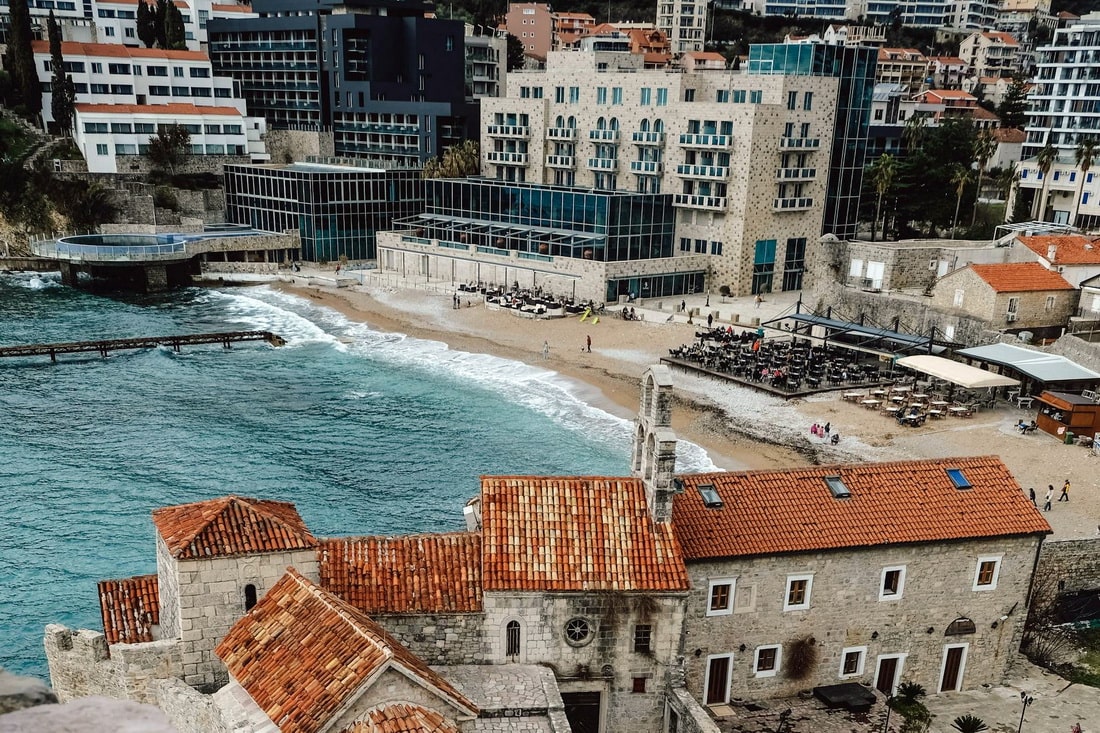
In summer, the beach near the old town walls is overcrowded. It’s better to go further away for swimming and sunbathing. Photo: Azra Tuba Demir
Distance from Budva: In the Old Town
Beach surface: Sand and pebbles
Details: Right by the Old Town walls, this small beach gets crowded and pricey in summer as the café takes up most of the space. Perfect for stunning photos with the ancient fortress walls as a backdrop.
How to get there: Easily accessible by foot.
Slovenska Plaža
Distance from Budva: Near the port, towards Bečići
Beach surface: Sand, pebbles, and concrete
Details: Budva’s main beach with changing rooms, bars, and a seaside promenade. Each restaurant has its own section with loungers, available when you order food or drinks. Free sections exist but are less maintained. Expect crowds during peak season.
How to get there: Easily accessible by foot or local transport.
Mogren
Distance from Budva: 1.5 km
Beach surface: Sand and pebbles
Details: Split into Mogren I and the quieter Mogren II, separated by a rock passage. Both beaches have loungers, showers, cafés, and water activities. Open from 8:00 to 21:00, with the gate closing after.
How to get there: Accessible by a scenic walk along the sea, where you’ll see the famous ballerina statue on the path.
Bečići
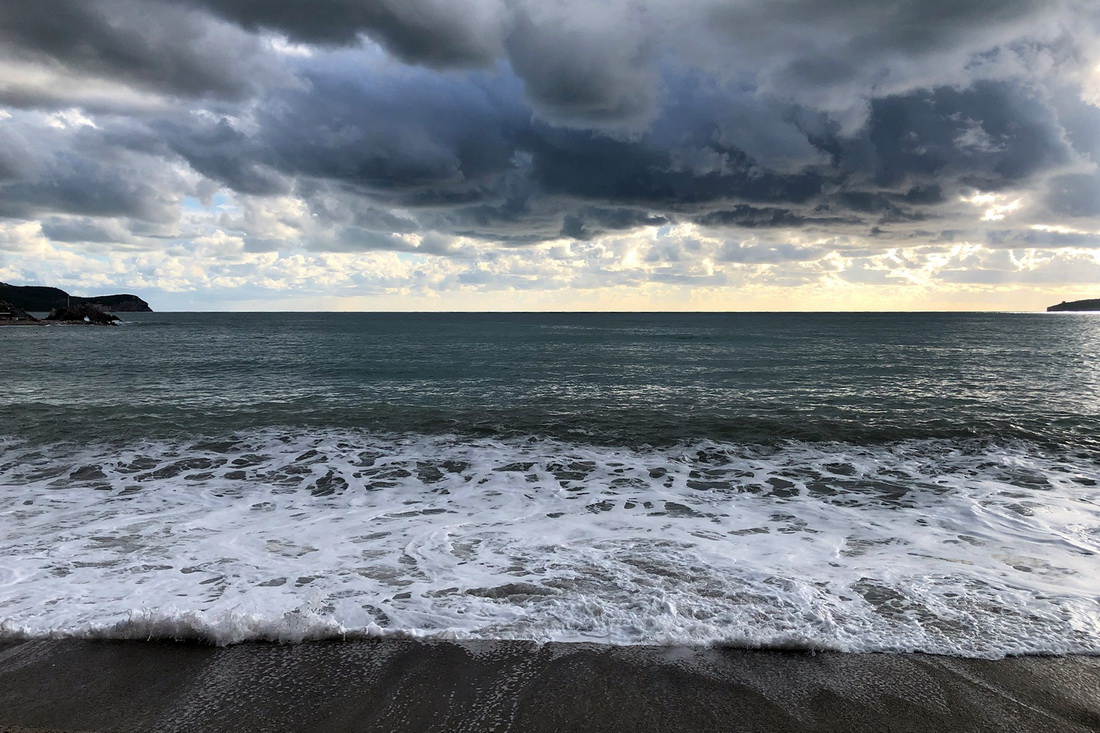
Love the sea before a storm! Empty beach vibes — these days are rare in the summer. Photo: Alexey Syrkovsky
Distance from Budva: 3 km
Beach surface: Sandy-pebble
Details: Wide beaches with loungers, cafés, and restaurants. Large hotels and apartments are plentiful. Be cautious when apartment hunting: a panoramic view might place you high on a hill. The sea appears close on the map, but expect a steep trek down to the beach and back up.
How to get there: By foot, a 40-minute walk from Budva along a wide, scenic path by the sea. Or by local bus from Budva’s main avenue, Jadranski Put. Buses run every 15-20 minutes.
Rafailovići
Distance from Budva: 4 km
Beach surface: Sandy-pebble
Details: Similar amenities to Bečići.
How to get there: Accessible on foot or by local bus from Budva.
Jaz
Distance from Budva: 6 km towards Tivat
Beach surface: Sand and pebbles
Details: A wide beach with full facilities.
How to get there: Only accessible by car or taxi. Not recommended for walking as the sidewalk ends midway, forcing you to walk along a busy highway.
Kamenovo
Distance from Budva: 6 km
Beach surface: Sandy-pebble
Details: Relatively wild beach with a bar playing loud music and equipped with loungers.
How to get there: By foot from Rafailovići via a path.
Pržno
Distance from Budva: 7 km
Beach surface: Sandy-pebble
Details: A small beach with sunbeds costing €20. It’s a starting point for a lovely promenade to Sveti Stefan (around 20 minutes). Nearby restaurants serve fresh fish dishes at reasonable prices.
How to get there: By foot, taxi, or local bus from Budva.
Milocer Queen’s Beach
Distance from Budva: 8 km
Beach surface: Sand and small pebbles
Details: A picturesque semicircular bay surrounded by light cliffs. Free for Kraljicina Plaza Hotel guests since July 2023, while outsiders pay €200.
How to get there: By car or taxi from Budva.
Milocer King’s Beach
Distance from Budva: 8 km
Beach surface: Sandy
Details: A beautiful beach that becomes pay-to-access in high season, costing €200, making it largely unused.
How to get there: By car or taxi from Budva.
Where to watch the sunset in and around Budva
In every new city, I love catching the sunrises and especially the sunsets. It’s such a calming and delightful experience. Budva and its surroundings have some amazing spots for this!
1. The seaside in Budva
You can enjoy breathtaking views of the Old Town of Budva and the sea from the beaches stretching from the Citadel towards Mogren. Sit on the sand and take in the mesmerizing scenery.
2. Pojata Restaurant
Coordinates: 42.31828, 18.82330
A 6 km walking route along a paved road into the mountains above Budva. Start at Podmaine Monastery and head uphill on the paved road. With hardly any cars, it’s a comfortable walk. At the top, you’ll find a family restaurant, a small waterfall, and a stunning sunset.
2. Church of St. Sava
Coordinates: 42.25784, 18.90096
It is 13 km from Budva. It’s best to take a bus to Sveti Stefan and hike up to the Church of St. Sava from there.
3. Mount Čelobrdo
Coordinates: 42.26438, 18.90011
You can reach Mount Čelobrdo on foot from the village of Sveti Stefan. The hike from the beach to the viewpoint is 2.5 km, with 1 km along an old stone path. It takes about 1.5 hours each way with stops.
4. Kosmač Fort
Coordinates: 42.30134, 18.90048
Kosmač is an Austrian fort from the mid-19th century. The exterior is in decent shape, but the interior is filled with rubble. Be careful, as there are bats inside. Kosmač stands at an elevation of 800 meters above sea level, so it’s noticeably cooler in the evening compared to the coast.
You can reach Kosmač Fort by taking the Budva – Brajići bus. Buses run every 30 minutes to an hour, cost €1.5-2, and the journey takes 25 minutes.
What about prices in Budva?
A few years ago, Budva, along with the rest of Montenegro, was renowned for its low prices. However, in recent times, the cost of groceries, tours, and other expenses has increased significantly and continues to rise. Despite this, it’s still a good time to visit if you’re looking to explore the country without breaking the bank. Prices are climbing, so taking advantage of the current rates allows you to enjoy Montenegro on a relatively modest budget before it becomes more expensive.
Accommodation
Finding accommodation in Budva is easy, with options ranging from first-class luxury hotels to apartments.
Hotels
3-4* hotels: Prices range from €60 to €200 per night.
Larger hotels: Located closer to Bečići, with prices starting from €100 per night.
Boutique hotels: Found in the Sveti Stefan area, these small establishments offer stunning views, spas, and designer interiors. Prices can reach up to €420 per night in peak season.
Guesthouses and hostels
Located closer to the Old Town.
Rooms start from €20-25 per night.
Apartments
July and August: Prices start from €40 per night.
June and September: Prices start from €30 per night.
Other months: Easier to find cheaper options. For example, in November, you can rent an apartment for €300-500 per month.
Seasonal availability: In summer, most apartments are rented on a daily basis. In the low season, they are usually available only for long-term stays – a month or more.
Utility bills: May be included in the monthly rental price, but often paid separately.
The cost of electricity, water, and internet for a one-bedroom apartment can be around €90-120 per month.
Booking tips: It’s advisable to book summer accommodation in advance.
In other months, you can easily find an apartment shortly before your trip.
Winter considerations: If you’re looking for long-term accommodation, make sure the apartment has adequate heating. Winter in Budva is damp and windy, so it’s difficult to manage without heating.
Tourist tax
In Montenegro, there’s a mandatory tourist tax. In Budva, it’s €1 per day, but the rate can vary in other cities.
Private apartments: Make sure to check if the tax is included in the rental price or if you’ll need to pay it separately. This information is usually mentioned in the property description.
Hotels: When staying in a hotel, the tourist tax is often included in the room rate, and registration is usually handled for you.
Food
I’ll talk more about the food a bit later, when I’ll mention what you should try. Prices here are average, in my opinion, roughly the same as in Italy.
For example, some prices in summer 2023:
Chicken: €3 per kg
Potatoes: €1 per kg
Cucumbers: €2 per kg
Tomatoes: €1.50 to €3 per kg
Nectarines: €1.50 per kg
Milk: €1 to €1.50 per litre
Grano Padano cheese: 200g for €6
Eggs: €2 for 10 pieces
Basmati rice: €2 per kg
Beef: Starting from €7 per kg
Fish: Starting from €8 per kg
Sweet bun: €1.50 each
Mineral water: €0.70 for a 1.5-litre bottle
Red wine: Ranges from €3.50 to €10 per bottle
Transport
Bus fares: €3-4 from Budva to Kotor (23 km) and €3-4 from Tivat to Budva (21 km).
Luggage fee on buses: €1.
Taxi: from Tivat Airport to Budva (21 km) costs €45-50 per car, from Budva to Bečići (3 km): €7
How much to send a postcard from Budva?
As an avid postcrosser — an enthusiast of exchanging postcards that have been sent through the mail — I recommend buying postcards in the city. Some souvenir shops also sell stamps. At the post office, I had to stand in line, and the staff were not very friendly. Maybe you’ll have better luck. But the postcard reached its recipients!
Postcard – €1
A stamp for sending a postcard to Germany costs €0.95, and to Australia – €1.05
What to eat in Budva?
Budva has plenty of restaurants and cafes. Prices on the promenade are 1.5 to 2 times higher than those on the streets further from the sea.
The food is a blend of Mediterranean and Balkan cuisine. It means plates often come loaded with meat. Vegetarians might find it a bit challenging.
Meat dishes
Njeguški steak: A beef or pork steak stuffed with pršut (smoked or cured ham) and kaymak (a dairy product similar to mild cheese). A portion costs about €20 and is enough for two.
Ćevapi: Small sausages made from minced meat with onions and spices. Served with fries and vegetables for around €10 per portion.
Pljeskavica: A flat, round patty of minced meat. Also served with fries and vegetables, costs around €6-10 per portion.
Seafood
Seafood is expensive, and not all chefs know how to prepare it well. In Budva, you can try fish dishes at the promenade restaurants. I’ll tell you where to buy fresh fish and seafood in Budva later.
Starters
Šopska salad: Made from tomatoes, peppers, cucumbers, and feta cheese. A national dish in many Balkan countries, it is the cheapest salad at around €5.
Pršut, cheese, kajmak: Popular Montenegrin starters. Kajmak (kaymak) is served both as a standalone dish and as a sauce.
Wine
Montenegro has two main types of wine —Vranac and Krstac.
Vranac: A deep dark ruby red wine with a complex bouquet.
Krstac: A light yellow white wine with an exquisite taste, perfect with meat dishes and cheeses.
Tea, coffee, lemonade
Tea: Black tea is hard to find, even in supermarkets, where you’ll mostly see a couple of herbal varieties.
Coffee: Loved here and usually prepared Turkish-style. Regular ground coffee like Lavazza is rare in stores. To try local coffee in a restaurant, ask specifically for local coffee; otherwise, you’ll likely get a rather weak Americano.
Homemade lemonade: Simply water with lemon, pleasantly sugar-free.
Where to buy fish, kaymak, and fruits in Budva
Budva has a variety of grocery stores, both large and small, and two markets. If you plan to cook for yourself, basic groceries for one person per week will cost around €40-45 for staples like rice, lentils, vegetables, and some meat or fish. Add at least another €20 if you, like me, enjoy plenty of greens and fruits.
You can buy vegetables and fruits at supermarkets or the Zelena Pijaca market. The selection is nearly the same, but supermarket prices are 25-50% lower.
Market vendors often claim their produce is homegrown, but in reality, many items are imported.
Hypermarkets and supermarkets
HDL: Located on Žrtava Fašizma Avenue, it’s about 1 km from the sea. The only hypermarket in Budva, it’s a two-storey store with a wide range of groceries and general goods. Closed on Sundays.
Supermarkets: Chains like Mega Market, Idea, Franca and Voli are plentiful throughout the city. They are suitable for daily grocery shopping, some of them have sections for fresh meat and cheese. Prices in supermarkets and the hypermarket are roughly the same.
Markets
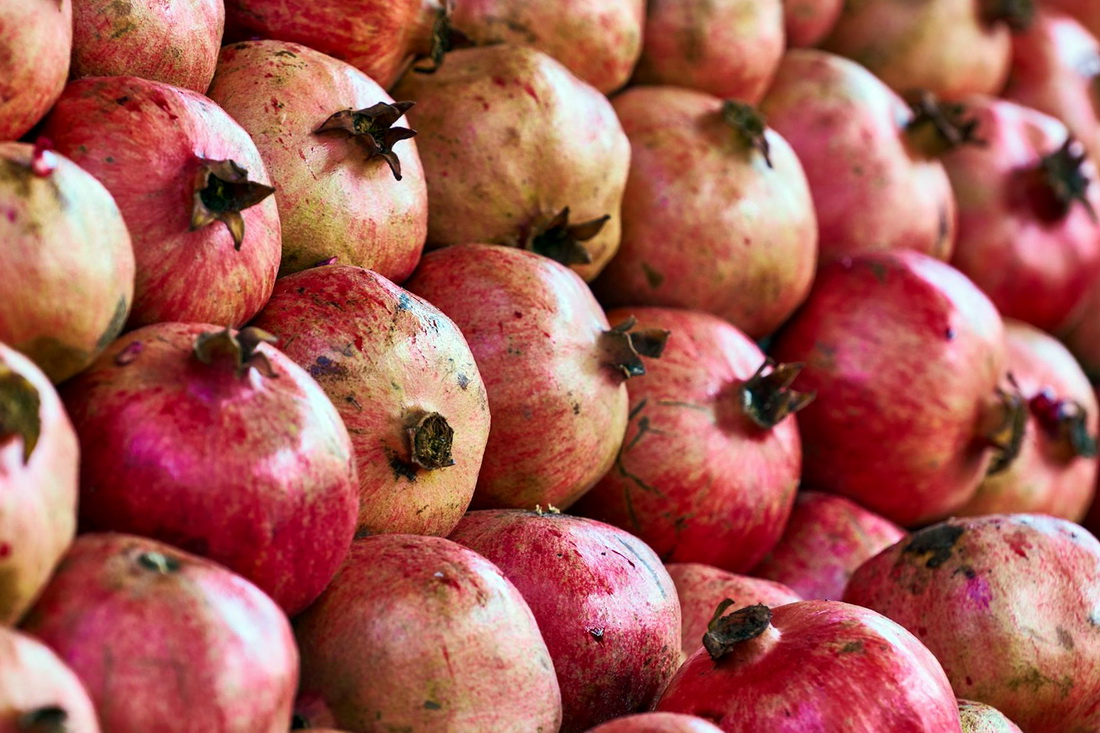
Local pomegranates might look a bit rough, sometimes with a greenish side, but I’ve never tasted anything better!
Zelena Pijaca: Located on Mediteranska Avenue, near Slovenska plaža. You can buy meat, cheese, kaymak, olives, and olive oil. Not all products are local, especially the fruits. In season (late September to late November), try the pomegranates — they are very tasty. Prices are high because the market is aimed at tourists.
Tržnica: Located at Filipa Kovačevića, 600 metres from the sea, next to Hotel Kadmo. This market sells only fruits and vegetables, with slightly lower prices than Zelena Pijaca.
Fresh fish

Not all the fish at the market is caught in the sea; some is farm-raised and brought in from other countries.
Tiny fish market: Operates in the summer near the port. Fresh supplies arrive after 16:00, and it’s the cheapest place in Budva to buy fish. Prices start at €8 per kg.
Zelena Pijaca Market: There is a tiny shop without big signs, located near Mega Market and Pekara Bakery. It offers 8-10 types of fish and seafood, including dorado, plaice, seabass, squid, and shrimp. Most fish cost around €12 per kg. However, note that not all the fish are wild from the Adriatic; some are farmed in other countries. You can ask them to grill the fish for you, which takes about half an hour.
When to visit Budva
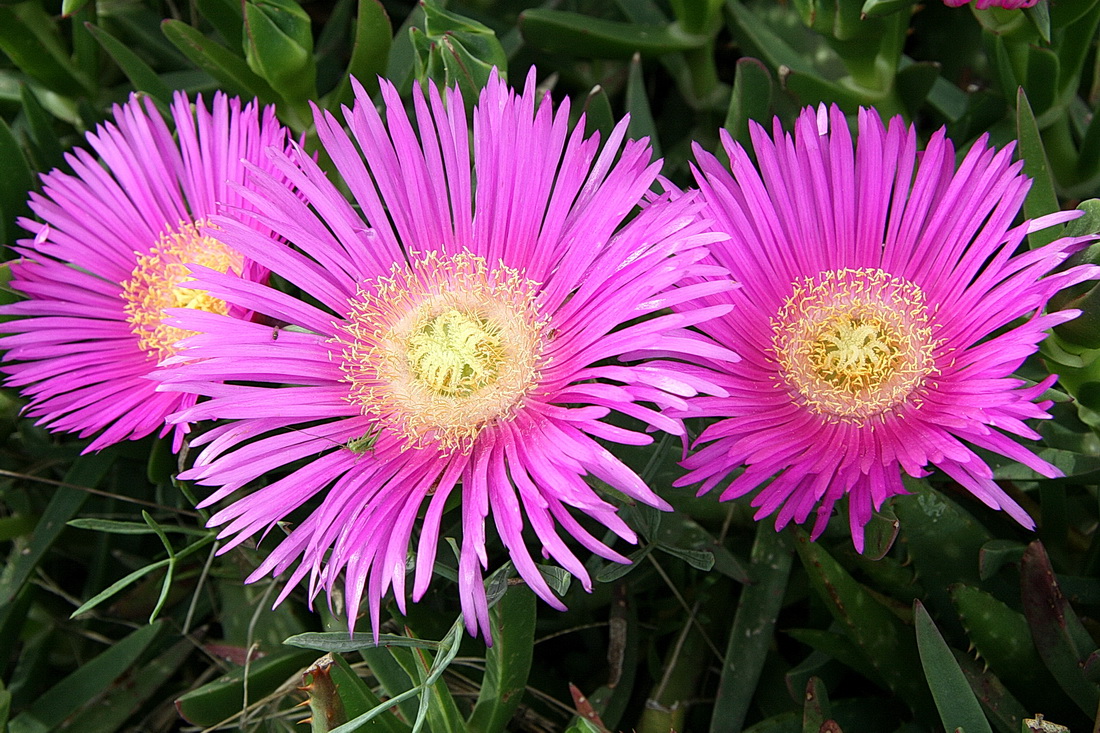
For me, the best time is April-May. It’s still cold in my country, but here there’s beauty at every step.
Budva’s beaches are popular in June, July, and August, but during these months, it’s very crowded with tourists, long queues, and higher prices for accommodation and restaurants.
The ideal months to visit are April, May and September. The weather is warm, sunny, and full of blooming flowers, though it can often be cloudy, and the sea might still be a bit chilly for swimming. However, it’s perfect for walking along the shore and hiking in the mountains.
In September, the number of tourists starts to decrease, but the sea remains warm enough for swimming, with sea temperatures around 25°C and air temperatures ranging from 25°C to 28°C. Rain is infrequent, averaging about five days, typically occurring later in the month.
As September progresses, the water temperature drops to a brisk 18-19°C. Evenings may require a windbreaker and jeans. Nonetheless, the sea can remain warm throughout the month. This is a wonderful time for a healthy holiday, with plenty of opportunities for walking and hiking.
In January and February, the weather is dreadful – it can rain for several days, and there are stormy winds. Homes are typically heated with air conditioners.
How to get to Budva
Montenegro has two airports: Podgorica (TGD) and Tivat (TIV). Unfortunately, there are no direct buses from the airports to Budva.
Tivat Airport to Budva (21 km)
The nearest airport to Budva is Tivat Airport.
By bus:
There is no direct bus from Tivat Airport to Budva. The most budget-friendly option is to walk 150 meters to the Jadranska magistrala (the highway connecting Tivat and Budva) and catch a passing bus.
You need buses heading to Budva, Podgorica, and Bar. They run 1-2 times per hour. Tickets cost around €3-4. The advantage is the low cost, but the downside is waiting on the highway in the heat with your luggage.
Alternative 1: During the peak season, tourist buses often pick up groups. If you see such a bus, you can ask the driver if they can take you to Budva for a fee (€3-5).
Alternative 2: Another option is to take a taxi to the Tivat bus station, about 1.5 km from the airport. The journey takes 25-35 minutes, and tickets cost €3-4 depending on the operator. Check the schedule on busticket4.me.
By taxi:
A taxi from Tivat Airport to Budva costs €45-50 per car and takes about 25 minutes.
Podgorica Airport to Budva (65 km)
Podgorica Airport is further from Budva, and like Tivat, there are no direct buses from the airport to the resorts.
By train and bus:
You can take a train for €2 (about a 1 km walk from the airport to the rail station) or a taxi for €10-15 to the Podgorica bus station. From there, you can catch one of the more than 30 daily buses to Budva. Tickets cost €6-7. The entire journey from the airport to Budva will take at least 2 hours.
By taxi:
A taxi from Podgorica Airport to Budva costs €65-70 depending on the company and takes about 1 hour and 10 minutes.
Dubrovnik-Budva (75 km)
Another option is to fly into Dubrovnik Airport in Croatia, which is close to the Montenegrin border. From the airport, head into Dubrovnik. Buses to Budva run several times a day from there. The trip takes about 2.5 hours and tickets cost €26-27.
Even when buying tickets online, you still need to print them at the ticket office and pay a service fee.
In Budva
Buses arrive at the bus station in Budva, which is a bit far from the beaches and many hotels. From the station, you’ll need to either walk to your hotel or take a taxi. A taxi ride from the Budva bus station to your accommodation costs about €2 for the initial fare plus €1 per km, so the total should be around €4-5.
Buses run along the Sveti Stefan – Petrovac line, making several stops in Budva.
Public transport in Montenegro has many issues. Buses often run off-schedule, which can mean waiting up to an hour at stops. They are often shabby, stuffy, and overcrowded. This isn’t always the case, but it’s good to be prepared and plan your travel with extra time.
Bicycles
Some private companies in the city rent out bicycles, electric scooters, and other devices. However, there are limited facilities for riding, as there are no dedicated bike lanes. You can ride along the promenade, but be aware that it can get crowded and the pavement is sometimes uneven.
Is Budva safe?
Budva is generally safe for travellers, including solo female travellers, but it’s important to stay vigilant, particularly against pickpockets in tourist-heavy areas. Here are some tips to ensure your safety:
Personal belongings: Keep a close watch on your belongings, use cross-body bags to deter theft, and avoid leaving valuables unattended, especially on public transport.
Alcohol consumption: Be cautious when drinking with locals, especially with rakija—a strong alcoholic drink similar to vodka. Typically, it’s 40% alcohol, but homemade rakija can be 60% or more. While it’s a gesture of hospitality, it’s best to limit yourself to one serving or politely decline if you’re unaccustomed to strong spirits.
Social interactions: Montenegrins enjoy chatting with foreigners, and in 99.9% of cases, it’s a pleasant and harmless conversation. However, be aware that someone might try to ingratiate themselves with you, potentially leading to the loss of belongings or making a costly purchase. This is rare but worth noting.
Smoking: Inhabitants of Montenegro tend to smoke quite heavily, so you might occasionally find yourself troubled by the smoke.
On the roads
Road conditions: Montenegrin roads are typically narrow and winding, especially in more remote areas. Locals often disregard traffic rules.
Driving habits: Drivers may not maintain a safe distance between vehicles, tend to overtake on curves by moving into the oncoming lane, and frequently exceed speed limits. However, don’t be alarmed by the constant beep-beep—it’s a friendly gesture used by local drivers to greet each other, show respect, or signal to yield the road.
In nature
Flora: Oleander, prevalent in parks and gardens, is beautiful but toxic. Avoid contact with this plant, as all its parts are poisonous.
Fauna: Exercise caution regarding snakes, spiders, and scorpions during hikes, especially off the beaten path. Although encounters are rare in heavily trafficked tourist spots and coastal areas, vigilance is crucial.
Ticks: Ticks are common across Europe and can transmit diseases such as encephalitis. If you are hiking in mountainous or wooded areas, regularly check your body to ensure no ticks have attached themselves. Ticks are most active in spring.
Do people in Budva speak English?
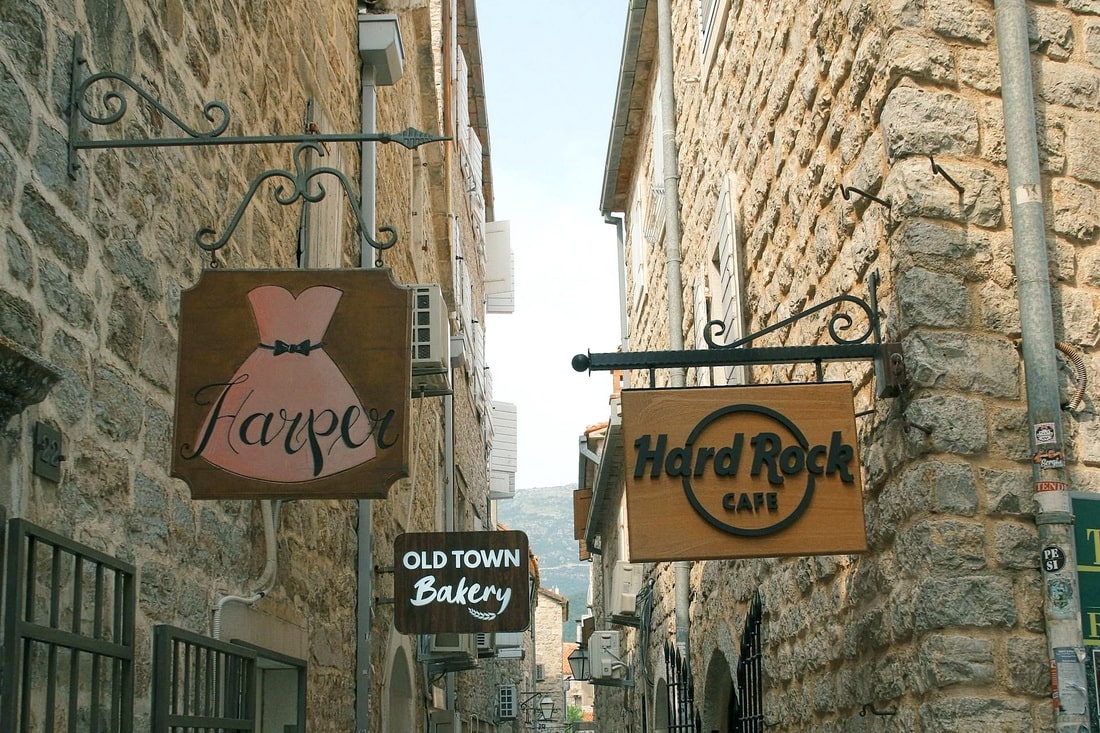
Generally, in Montenegro, it’s not difficult to figure out where to eat, where the market is, and where the restroom is.
Budva, being a popular tourist city, has many residents who speak English, especially younger people and those working in hospitality and retail.
However, in rural areas, English proficiency may be lower, particularly among the older population.
Restaurant menus typically offer translations in English, Russian, and often Italian.
